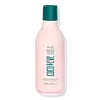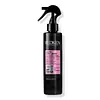What's inside
What's inside
 Key Ingredients
Key Ingredients

 Benefits
Benefits

 Concerns
Concerns

 Ingredients Side-by-side
Ingredients Side-by-side

Water
Skin ConditioningSodium C14-16 Olefin Sulfonate
CleansingSodium Methyl Cocoyl Taurate
CleansingCetyl Betaine
CleansingSodium Cocoamphoacetate
CleansingLauryl Glucoside
CleansingGlycerin
HumectantCocos Nucifera Oil
MaskingAnanas Sativus Fruit Extract
Skin ConditioningNephelium Lappaceum Branch/Fruit/Leaf Extract
Skin ConditioningHydrolyzed Hyaluronic Acid
HumectantArgania Spinosa Kernel Oil
EmollientFicus Carica Fruit Extract
HumectantPersea Gratissima Oil
Skin ConditioningHydrolyzed Pea Protein
EmollientSapindus Trifoliatus Fruit Extract
Skin ConditioningSodium Hyaluronate
HumectantCocos Nucifera Fruit Juice
EmollientCocos Nucifera Water
MaskingPsidium Guajava Fruit Extract
AstringentPhospholipids
Skin ConditioningGlycol Distearate
EmollientPolyquaternium-22
Sodium Cocoyl Glutamate
CleansingSodium Lauryl Glucose Carboxylate
CleansingSodium Stearoyl Lactylate
EmulsifyingGlyceryl Caprylate
EmollientGlyceryl Stearate
EmollientPropanediol
SolventCetearyl Alcohol
EmollientTetrasodium Glutamate Diacetate
Glyceryl Undecylenate
EmollientPolyglyceryl-10 Dioleate
EmulsifyingPolyglyceryl-10 Oleate
Skin ConditioningGuar Hydroxypropyltrimonium Chloride
Skin ConditioningCocamidopropyl Betaine
CleansingLaureth-4
EmulsifyingAcrylates/C10-30 Alkyl Acrylate Crosspolymer
Emulsion StabilisingSodium Benzoate
MaskingPotassium Sorbate
PreservativeParfum
MaskingBenzyl Salicylate
PerfumingCoumarin
PerfumingLinalool
PerfumingCitric Acid
BufferingWater, Sodium C14-16 Olefin Sulfonate, Sodium Methyl Cocoyl Taurate, Cetyl Betaine, Sodium Cocoamphoacetate, Lauryl Glucoside, Glycerin, Cocos Nucifera Oil, Ananas Sativus Fruit Extract, Nephelium Lappaceum Branch/Fruit/Leaf Extract, Hydrolyzed Hyaluronic Acid, Argania Spinosa Kernel Oil, Ficus Carica Fruit Extract, Persea Gratissima Oil, Hydrolyzed Pea Protein, Sapindus Trifoliatus Fruit Extract, Sodium Hyaluronate, Cocos Nucifera Fruit Juice, Cocos Nucifera Water, Psidium Guajava Fruit Extract, Phospholipids, Glycol Distearate, Polyquaternium-22, Sodium Cocoyl Glutamate, Sodium Lauryl Glucose Carboxylate, Sodium Stearoyl Lactylate, Glyceryl Caprylate, Glyceryl Stearate, Propanediol, Cetearyl Alcohol, Tetrasodium Glutamate Diacetate, Glyceryl Undecylenate, Polyglyceryl-10 Dioleate, Polyglyceryl-10 Oleate, Guar Hydroxypropyltrimonium Chloride, Cocamidopropyl Betaine, Laureth-4, Acrylates/C10-30 Alkyl Acrylate Crosspolymer, Sodium Benzoate, Potassium Sorbate, Parfum, Benzyl Salicylate, Coumarin, Linalool, Citric Acid
Water
Skin ConditioningDimethicone
EmollientStearyl Alcohol
EmollientBehentrimonium Chloride
PreservativeTrideceth-9 Pg-Amodimethicone
Skin ConditioningPhenoxyethanol
PreservativePolysorbate 20
EmulsifyingParfum
MaskingIsopropyl Alcohol
SolventPPG-5-Ceteth-20
EmulsifyingLaureth-23
CleansingLaureth-4
EmulsifyingTrideceth-12
EmulsifyingGlycine Soja Oil
EmollientTocopherol
AntioxidantXylose
HumectantArginine
MaskingGlutamic Acid
HumectantLimonene
PerfumingPropylene Glycol
HumectantSerine
MaskingSalicylic Acid
MaskingLinalool
PerfumingBenzyl Salicylate
PerfumingPEG/PPG-4/12 Dimethicone
EmulsifyingBenzyl Alcohol
PerfumingAlpha-Isomethyl Ionone
PerfumingCoumarin
PerfumingPentaerythrityl Tetra-Di-T-Butyl Hydroxyhydrocinnamate
AntioxidantWater, Dimethicone, Stearyl Alcohol, Behentrimonium Chloride, Trideceth-9 Pg-Amodimethicone, Phenoxyethanol, Polysorbate 20, Parfum, Isopropyl Alcohol, PPG-5-Ceteth-20, Laureth-23, Laureth-4, Trideceth-12, Glycine Soja Oil, Tocopherol, Xylose, Arginine, Glutamic Acid, Limonene, Propylene Glycol, Serine, Salicylic Acid, Linalool, Benzyl Salicylate, PEG/PPG-4/12 Dimethicone, Benzyl Alcohol, Alpha-Isomethyl Ionone, Coumarin, Pentaerythrityl Tetra-Di-T-Butyl Hydroxyhydrocinnamate
 Reviews
Reviews

Ingredients Explained
These ingredients are found in both products.
Ingredients higher up in an ingredient list are typically present in a larger amount.
Benzyl Salicylate is a solvent and fragrance additive. It is an ester of benzyl alcohol and salicylic acid. This ingredient can be naturally found in some plants and plant extracts.
In fragrances, Benzyl Salicylate may be a solvent or a fragrance component. In synthetic musk scents, it is used as a solvent. For floral fragrances such as lilac and jasmine, it is used as a fragrance component. The natural scent of Benzyl Salicylate is described as "lightly-sweet, slightly balsamic".
While Benzyl Salicylate has been associated with contact dermatitis and allergies, emerging studies show it may not be caused by this ingredient alone.
However, this ingredient is often used with fragrances and other components that may cause allergies. It is still listed as a known allergen in the EU. We recommend speaking with a professional if you have concerns.
Another study from 2021 shows Benzyl Salicylate may have anti-inflammatory properties.
Learn more about Benzyl SalicylateCoumarins are a group of substances found naturally in plants. There are over 1300 types of coumarins identified. It has a natural vanilla scent.
Coumarin is an identified EU known allergy, meaning it may cause an allergic reaction when applied to the skin.
In many countries, coumarin is banned as a food additive. However, it can be found in soaps, tobacco products, and some alcohol drinks.
Plants use coumarins as a chemical defense. Some plants that have coumarins include lavender, tonka beans, and yellow clovers.
Learn more about CoumarinLaureth-4 is created by reacting ethylene oxide with Lauryl Alcohol. It is a surfactant and emulsifier.
Surfactants reduce the surface tension of ingredients so they can mix better. Emulsifiers prevent ingredients such as oil and water from separating.
Linalool is a fragrance and helps add scent to products. It's derived from common plants such as cinnamon, mint, citrus, and lavender.
Like Limonene, this ingredient oxidizes when exposed to air. Oxidized linalool can cause allergies and skin sensitivity.
This ingredient has a scent that is floral, spicy tropical, and citrus-like.
Learn more about LinaloolParfum is a catch-all term for an ingredient or more that is used to give a scent to products.
Also called "fragrance", this ingredient can be a blend of hundreds of chemicals or plant oils. This means every product with "fragrance" or "parfum" in the ingredients list is a different mixture.
For instance, Habanolide is a proprietary trade name for a specific aroma chemical. When used as a fragrance ingredient in cosmetics, most aroma chemicals fall under the broad labeling category of “FRAGRANCE” or “PARFUM” according to EU and US regulations.
The term 'parfum' or 'fragrance' is not regulated in many countries. In many cases, it is up to the brand to define this term.
For instance, many brands choose to label themselves as "fragrance-free" because they are not using synthetic fragrances. However, their products may still contain ingredients such as essential oils that are considered a fragrance by INCI standards.
One example is Calendula flower extract. Calendula is an essential oil that still imparts a scent or 'fragrance'.
Depending on the blend, the ingredients in the mixture can cause allergies and sensitivities on the skin. Some ingredients that are known EU allergens include linalool and citronellol.
Parfum can also be used to mask or cover an unpleasant scent.
The bottom line is: not all fragrances/parfum/ingredients are created equally. If you are worried about fragrances, we recommend taking a closer look at an ingredient. And of course, we always recommend speaking with a professional.
Learn more about ParfumWater. It's the most common cosmetic ingredient of all. You'll usually see it at the top of ingredient lists, meaning that it makes up the largest part of the product.
So why is it so popular? Water most often acts as a solvent - this means that it helps dissolve other ingredients into the formulation.
You'll also recognize water as that liquid we all need to stay alive. If you see this, drink a glass of water. Stay hydrated!
Learn more about Water